
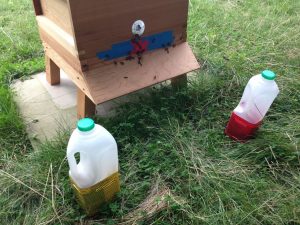 |
| DrBeekeeper’s two pronged strategy for protecting a bee colony from wasp attack |
A few weeks ago I noticed a few wasps roaming around my new hive and thought nothing of it until I soon found the wasps were actually entering my hive through the entrance. The colony was small so the guard bees at the entrance were not strong enough to resist the wasps attacking bees. I ignored this for a while, hoping it would sort itself out, only to find a few days later a major battle occurring between the bees and wasps at the hive entrance.
Observing the hive entrance at this time was like looking at a warfield. The wasps were ferocious, literally flying at bees near the hive entrance, lifting them into the air and depositing them in the ground in front of hive. At times, they would simply walk into the hive with no resistance from the bees whatsoever. During this time, I had read about how wasps can actually dismember bees and destroy colonies. I had worked hard to make this new colony – I couldn’t bear to allow the wasps to kill my bees!
So I developed a two pronged strategy using trial and error to tackle these two key problems:
- The hive entrance is too wide for bees to defend
- There are too many wasps roaming around the hive
PROBLEM 1: The hive entrance is too wide for bees to defend
SOLUTION 1:
Restrict the entrance size with any sort of barrier. For cost saving, I simply used some strong duck tape and applied this on both sides of the entrance leaving a 1cm width gap in the centre to allow bees in an out (Experiment 1).
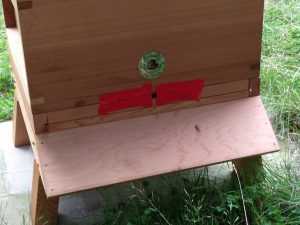 |
| Experiment 1 |
However, although less wasps were entering, there were still significant numbers gaining entry to the hive. So I then tried completely occluding the hive entrance with duck tape leaving a 6mm diameter hole (Experiment 2). Although this allowed bees in and out, I noticed that the single bee entry actually made it hard for the guard bees to defend the hive when a wasp chose to enter.
 |
| Experiment 2 |
During this time I read that wasps don’t like to enter tubes so I filled the 6mm hole with a short cutting of a straw (Experiment 3). This was hugely successful at ensuring no wasps entered the hive, but also had the undesired effect of stopping bees entering and leaving too!
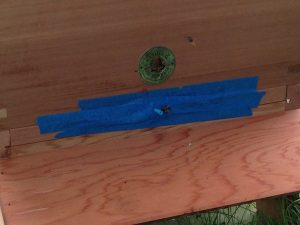 |
| Experiment 3 |
Finally, I came up with the final solution which really works. As before, the hive entrance was occluded with duck tape, leaving a 6mm diameter hole in the centre. Immediately in front of this hole, the metal cylindrical part of a garden hose tap connecter was placed and attached with duck tape. This worked because it allows bees into and out of the hive whilst also allowing sufficient space within the metal cylinder to allow the bees to defend themselves against attack.
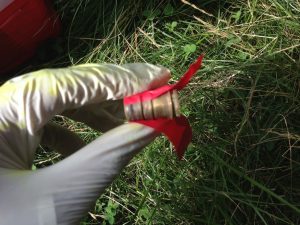 |
| Garden hose tap connector |
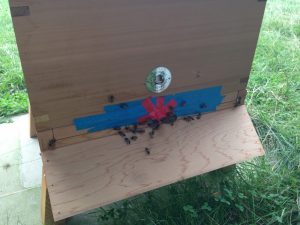 |
| The final solution |
PROBLEM 2: Too many wasps roaming around the hive
SOLUTION 2:
I decided to create a wasp trap to help reduce the numbers of wasps and therefore reduce the risk of them attacking the colony. The shop bought ones were expensive and I had read didn’t work very well. So I made my own which only takes 5 minutes and here’s how…
- Milk bottle (plastic and empty with lid in place)
- Scissors
- Ruler
- Nail or sharp object
- Opaque/dark-coloured duck tape
- Old fruit jam/juice or anything wasps like
- Apply tape to the lower half of the milk bottle (to prevent light from entering).
- 1 cm below the upper rim of the taped area, on all four sides, create flaps of approximately 4-6cm in width and 1cm in height (depending on the size of your bottle, these will be the entry points for the wasps).
- At the top of the milk bottle, around the lid create holes using a nail or sharp object (which will allow the smells of the trap contents to attract wasps).
- Fill the milk bottle to a level approximately 2 cm below the cut flaps with any substance which attracts wasps eg. rotten fruit, fruit juices, a few spoons of jam (note bees are not attracted to this disgusting mixture!).
- Finally, place the wasp trap in front of the hive or near the area where wasps are congregating.
- Every few days clear out the trap which will contain lots of wasps but should not contain any bees


Great to see all the stages you went through! Very ingenious.
Trial and error of a battle commander! Great stuff!
Superb tips. Thank you!!
Making a fake nest also keeps that wasps away. I’ve used a fake nest for the last few years and rarly see a wasp at my hives.
I used this pattern
https://www.etsy.com/transaction/48555126?ref=fb2_tnx_title
Thanks! It was interesting trying the different experiments – must come from my medical/science background!
Thanks Emma. Battle commander – sounds about right!
Thanks Alison, glad you liked the post. Hope it helps if you ever get trouble with wasps.
That’s really interesting – thanks for sharing that. Never could have imagined that, let alone that it would work! I wonder if it is the shape that deters them?
Use any large plastic bottle and drill a 10mm hole in the stopper. Mix jam with water and pour a few inches into the plastic bottle. Screw on the top. Hang the bottles from a nearby support. Wasps get into the bottle but cant get out. They cant fly up the bottle neck or turn upside down to escape. The dead wasps [and wax moths] drown in the jam!
I’m finding the wasps are a real problem this year and have reduced the bees entrances & in one instance have closed it as there was a small entrance as the block was a bit short hoping this will assist the bees to protect there limited entrance.
I have probably 10 jam jars with jam and water in the base. I cover the top with greaseproof paper smeared underneath with jam and around the inner top of the jar. Fixed on top with a rubber band with 5/6 holes in the paper with the carving fork and I have to empty the jar of dead wasps after 3/5 days.
Do you cut a v to make your flaps stick out for the wasps to enter? It sounds a good idea and perhaps can be left longer than my jam jars.
Thanks for your message. On each side of the wasp trap, I cut out a ‘n’ shape. By this I mean you draw a ‘n’ shape which is 1cm high and 4-6cm in width on the sides of the wasp trap, then cut with a scissor along the drawn ‘n’ shape. At this point the cut portion is flush with the rest of the bottle. In order to create the entrance for the wasps you have to push the ‘n’ flap inwards so that there is enough space for a wasp to enter. Yes, these traps can be left for longer as there is more space for the wasps to accumulate, but you do need to ensure there is enough liquid in the bottle for it to function properly. Hope this makes sense!
Yikes ours are been invaded normal wasps and German ones much bigger and fatter than the normal wasps and they are grabbing my babies on the wing, they particularly like my poor babies whose wings have disintegrated and carry them off alive, oh my I have put out the traps. Gee I pray it works and have closed down the entrance too.
are you sure the bee’s will not like the jam?
I’m sorry to hear your bees are suffering. It sounds like this has been going on for a while. The key thing is to intervene as soon as you notice a problem. I would recommend you continue as you are but also use Dr Beekeeper’s wet towel technique (see http://drbeekeeper.blogspot.co.uk/2013/11/the-wonders-of-wet-towel-in-warding-off.html?m=1). This should help further protect your bees from attack.
Yes jam works well. You can also try any old rotting fruit. Bees tend to have a more sophisticated palate!
Thanks for sharing this easy and practical wasps control method. I’ve seen various ways online of how to ret rid of wasps effectively, but the natural method is more preferable since it is safer compared of using those with harmful chemicals.
Superb experiments sir…..do you have the vedeo making this wasp trap for controlling surrounding wasps around apairy…as around my apiary there are…huge no wasps feeding on fallen fruits of fig tree and also on bees ….
Also let me know if you observed that did bees also enter these traps more than do wasp did….as bees are importnat to us……
Hi, the bees are not attracted to the contents of the trap. We only observed wasps being trapped. Best wishes, DrBeekeeper
Thank you for your post! We have lost a hive to wasps. we would like to clear the interior of the hive that is now full of wasps that are decimating what’s left and would like to introduce a new colony. Would you have suggestions on how to accomplish this? we have implemented the reduced opening and the wasp traps for our remaining hive which appears healthy at this point. . . I hate wasps!
Hi we have a bees nest in the eves of our bungalow
This morning hoards of wasps are attacking
I’ve climbed up a ladder and stuffed newspaper to reduce the size of the hole
Is there anything else I can do
Can’t bear to watch them piling in there
Hi Millie,
If you are sure they are bees nesting, then the best thing would be to get in contact with your local beekeepers association who should be able to put you in touch with someone who can help.
Best wishes,
DrBeekeeper
Hi Nette,
Sorry to hear about your loss. Would suggest waiting a few weeks before introducing a colony to that site. It will give a chance for the wasps to clear and help reduce the risk of the new bees being attacked. Remember to keep the entrance of the new hive small to help it defend itself.
Good luck!
DrBeekeeper
Some years ago I had 3 hives in an out Apiary, in an old Orchard.
All 3 were completely wiped out by wasps .
Today I have moved a colony out of a very okd Dadant hive into a New National, and Wasps are robbing stores from the old Brood frames as are some of the Bees from the new hive.
I have reduced the entrance on both hives and set an old Jam Jar trap for the wasps out side the old Dadant hive.
Then in 14 days time I will clear away the old hive.
At the moment it distracts the Wasps away from the new National hive.
I appreciate all your instructions I did narrow down my entrance and used a tube like entrance…that made a huge difference. I already had some store bought traps I put out…they were OK. I lucked out and found a wasp nest, yep…I got stung. Was standing right over it on a ladder painting my trim.
That was fun..hahaha.
I had same problem with my hives
What I did was set up an old hive with a large fly zapper in side
The number of wasps dropped within an hour
I did as you described, it worked very well! I did however use a tall clear plastic bottle rather opaque and then darken the bottom third. Thanks for the advice.
A few wasps were getting into my hive in spite of the water tap tube. I made a 2 inch long tube out of wire mesh (8 grade) to fit over the top of the brass tube, extending about an inch beyond the brass tube. The wasps could not handle that at all.